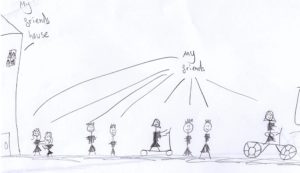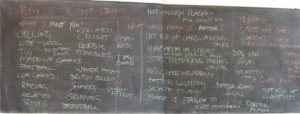
About fifteen years ago I was asked to work on proposals for a Homezone – an area where streets were modified to tip the balance away from cars and towards local people, especially children – around St.Barnabas School. I spent an afternoon with kids at the school working with them to identify outdoor places they used, what they did there, and what made them work well. The children quickly gave me a long list of games they played in the streets, using only kerbs, walls, lamp-posts and other available props. They also listed things which were problems (including “teenagers”. We all seem to have problems with everyone who is a different age to ourselves).

This week I revisited St.Barnabas – in its (relatively) new premises, and Poppleton Road school. I again worked with the children to ask them what outdoor spaces they used, and what they did there. The list was very different – very few of the children described playing in their street. Many described places which were “elsewhere” in relation to home – the seaside, the zoo, even cruise ships. One or two described being discouraged by their parents – “my parents don’t let me use the garden in case I mess it up” while for many others there was no garden, and the surrounding streets had ceased to be their realm. But they did wonderfully creative pictures which are on our Flickr site. Children at St.Barnabas described places they’d ideally like to spend time here, while children at Poppleton Road described their current favourite (real) places here. I also asked the children to identify the one quality which made their favourite place special – a quality which could be part of the brief for any new public space in a new part of town, and the list was:-
- Wildlife nearby
- Places which you can use for free
- Unexpected stuff – nice surprises
- Fun and pleasure (and ice-cream)
- (while we’re being greedy, let’s have fish and chips too)
- Places to skateboard which aren’t always skateparks
- Water
- Places to chill, which were calm
- Places to grow food (even Brussel Sprouts)
- Woodland to play and hide (and also show people trees are things of value)
- Usable outdoor space
- Shelter to do things or watch other people do things
- Places to play sports
- Personal space, including gardens (whether on the ground or the roof or a balcony)
- Places to stay such as camping places
- Safe streets which can be played in, even if there are cars around
- Places to walk dogs
I’ll be going back in a couple of weeks to talk about movement – how they get around – and will report back. Many thanks to the helpful and welcoming staff at both schools.
In addition to admiring the artwork in the Flickr albums, you can see how the issues the children thought important fit in with overall discussions. Simply go to our tags page here and click on any of the tags.